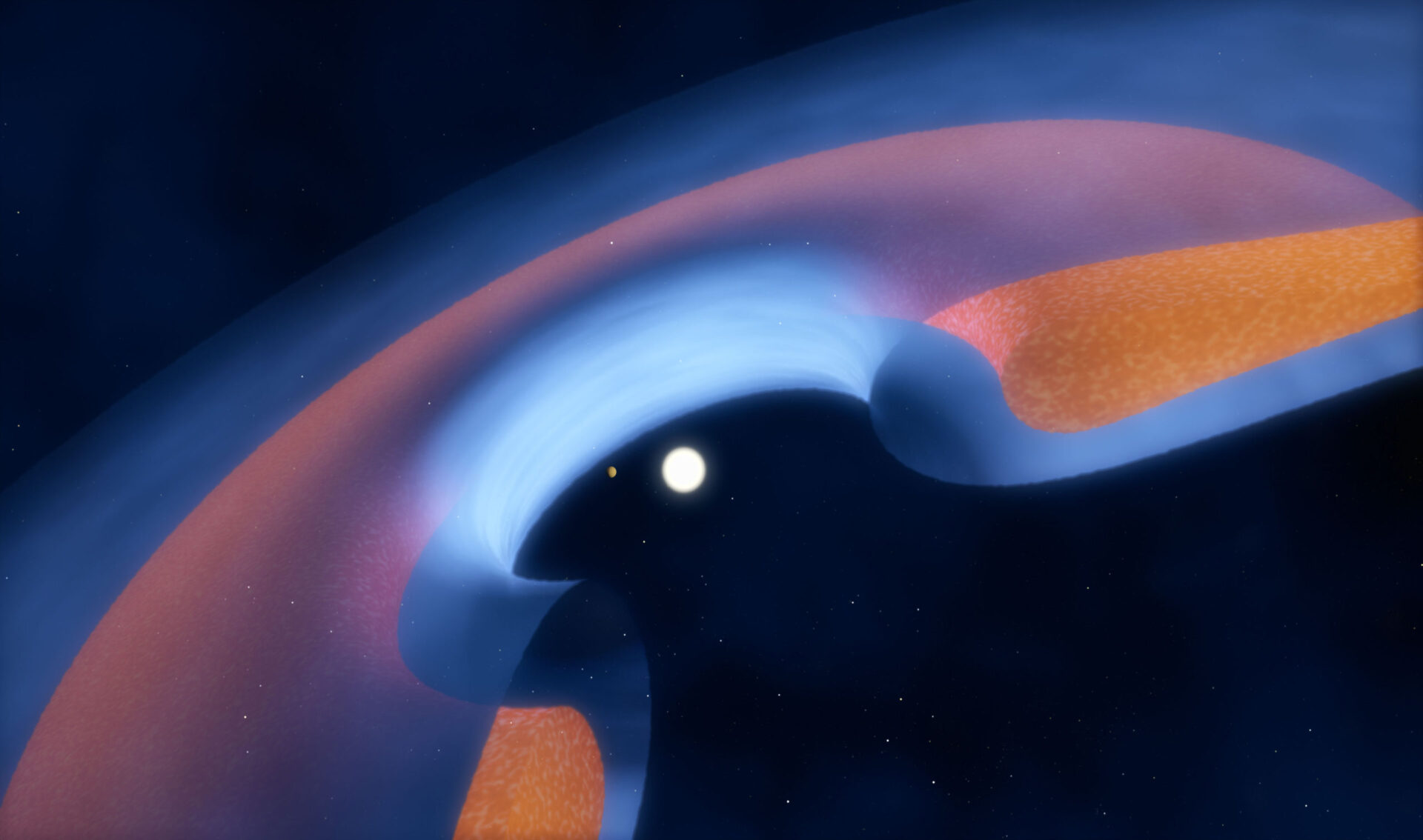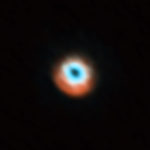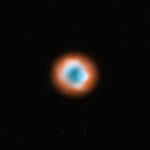ALMA Reveals Planetary Construction Sites
Astronomers using the Atacama Large Millimeter/submillimeter Array (ALMA) have found telltale differences between the gaps in the gas and the dust in discs around four young stars. These new observations are the clearest indications yet that planets with masses several times that of Jupiter have recently formed in these discs. Measurements of the gas around the stars also provide additional clues about the properties of those planets.
Planets are found around nearly every star, but astronomers still do not fully understand how — and under what conditions — they form. To answer such questions, they study the rotating discs of gas and dust present around young stars from which planets are built. But these discs are small and far from Earth, and the power of ALMA was needed for them to reveal their secrets.
A special class of discs, called transitional discs, has a surprising absence of dust in their centers, in the region around the star. Two main ideas have been put forward to explain these mysterious gaps. Firstly, the strong stellar winds and intense radiation could have blown away or destroyed the encircling gas and dust [1]. Alternatively, massive young planets in the process of formation could have cleared the material as they orbit the star [2].
The unparalleled sensitivity and image sharpness of ALMA have now allowed the team of astronomers, led by Nienke van der Marel from the Leiden Observatory in the Netherlands to map the distribution of gas and dust in four of these transitional discs better than ever before [3]. This in turn has allowed them to choose between the two options — photoevaporation or young planets — as the cause of the gaps for the first time.
The new images show that there are significant amounts of gas within the dust gap [4]. But to the team’s surprise, this disc of gas also possessed a gap, up to three times smaller than that of the dust. This could only be explained by the scenario in which the newly formed massive planet cleared the gas as it travelled around their orbit, but trapped the dust particles further out [5].
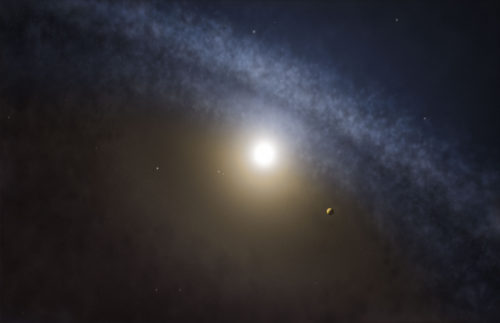
Artist’s impression of a transitional disc around a young star
Astronomers using the Atacama Large Millimeter/submillimeter Array (ALMA) have found telltale differences between the gaps in the gas and the dust in discs around four young stars. These new observations are the clearest indications yet that planets with masses several times that of Jupiter have recently formed in these discs. Credit: ALMA (ESO/NAOJ/NRAO)/M. Kornmesser

Schematic view of a transitional disc around a young star
This schematic diagram shows how the dust (brown) and gas (blue) is distributed around the star, and how a young planet is clearing the central gap. Credit: ALMA (ESO/NAOJ/NRAO)/M. Kornmesser
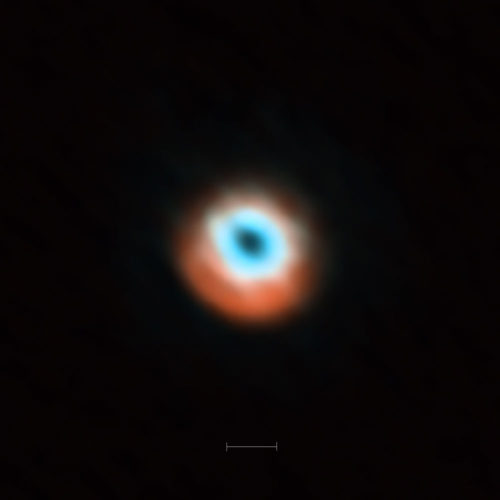
ALMA imaging of the transitional disc HD 135344B. This ALMA image combines a view of the dust around the young star HD 135344B (orange) with a view of the gaseous material (blue). The smaller hole in the inner gas is a telltale sign of the presence of a young planet clearing the disc. Credit ALMA (ESO/NAOJ/NRAO)

ALMA imaging of the transitional disc DoAr 44. This ALMA image combines a view of the dust around the young star DoAr 44 (orange) with a view of the gaseous material (blue). The smaller hole in the inner gas is a telltale sign of the presence of a young planet clearing the disc. Credit ALMA (ESO/NAOJ/NRAO)
“Previous observations already hinted at the presence of gas inside the dust gaps,” explains Nienke van der Marel. “But as ALMA can image the material in the entire disc in much greater detail than other facilities, we could rule out the alternative photoevaporation scenario. The deep gap points clearly to the presence of planets with several times the mass of Jupiter, creating these caverns as they sweep through the disc.”
Remarkably, these observations were conducted utilising just one tenth of the current resolving power of ALMA, as they were performed whilst half of the array was still under construction on the Chajnantor Plateau in northern Chile. Further studies are now needed to determine whether more transitional discs also point towards this planet-clearing scenario, although ALMA’s observations have, in the meantime, provided astronomers with a valuable new insight into the complex process of planetary formation.
“All the transitional discs studied so far that have large dust cavities also have gas cavities. So, with ALMA, we can now find out where and when giant planets are being born in these discs, and compare these results with planet formation models,” says Ewine van Dishoeck, also of Leiden University and the Max Planck Institute for Extraterrestrial Physics in Garching [6]. “Direct planetary detection is just within reach of current instruments, and the next generation telescopes currently under construction, such as the European Extremely Large Telescope, will be able to go much further. ALMA is pointing out where they will need to look.”
Animated artist’s impression of a transitional disc around a young star.
Astronomers using the Atacama Large Millimeter/submillimeter Array (ALMA) have found telltale differences between the gaps in the gas and the dust in discs around four young stars. These new observations are the clearest indications yet that planets with masses several times that of Jupiter have recently formed in these discs. Credit: ALMA (ESO/NAOJ/NRAO)/M. Kornmesser
Animated schematic view of a transitional disc around a young star
This schematic diagram shows how the dust (brown) and gas (blue) is distributed around the star, and how a young planet is clearing the central gap. Credit: ALMA (ESO/NAOJ/NRAO)/M. Kornmesser
Notes
[1] This process, which clears the dust and gas from the inside out, is known as photoevaporation.
[2] Such planets are difficult to observe directly and previous studies at millimeter wavelengths have failed to achieve a sharp view of their inner, planet-forming zones where these different explanations could be put to the test. Other studies could not measure the bulk of the gas in these discs.
[3] The four targets of these investigations were SR 21, HD 135344B (also known as SAO 206462), DoAr 44 and Oph IRS 48.
[4] The gas present in transitional discs consists primarily of hydrogen, and is traced through observations of the carbon monoxide — or CO — molecule.
[5] The process of dust trapping is explained in an earlier release.
[6] Other examples include the HD 142527 (eso1301 and here) and J1604-2130 transitional discs.
Additional information
This research was presented in a paper entitled “Resolved gas cavities in transitional disks inferred from CO isotopologs with ALMA”, by N. van der Marel, et al., to appear in Astronomy & Astrophysics in December 2015.
The team is composed of N. van der Marel (Leiden University, Leiden, the Netherlands; Institute for Astronomy, University of Hawaii, Honolulu, USA), E. F. van Dishoeck (Leiden University, Leiden, the Netherlands; Max Planck Institute for Extraterrestrial Physics in Garching, Germany), S. Bruderer (Max-Planck Institute for Extraterrestrial Physics, Garching, Germany), S. M. Andrews (Harvard-Smithsonian Center for Astrophysics, Massachusetts, USA), K. M. Pontoppidan (Space Telescope Science Institute, Baltimore, Maryland, USA), G. J. Herczeg (Peking University, Beijing, China), T. van Kempen (Leiden University, Leiden, the Netherlands) and A. Miotello (Leiden University, Leiden, the Netherlands).
The Atacama Large Millimeter/submillimeter Array (ALMA), an international astronomy facility, is a partnership of the European Organisation for Astronomical Research in the Southern Hemisphere (ESO), the U.S. National Science Foundation (NSF) and the National Institutes of Natural Sciences (NINS) of Japan in cooperation with the Republic of Chile. ALMA is funded by ESO on behalf of its Member States, by NSF in cooperation with the National Research Council of Canada (NRC) and the Ministry of Science and Technology (MOST) in Taiwan and by NINS in cooperation with the Academia Sinica (AS) in Taiwan and the Korea Astronomy and Space Science Institute (KASI).
ALMA construction and operations are led by ESO on behalf of its Member States; by the National Radio Astronomy Observatory (NRAO), managed by Associated Universities, Inc. (AUI), on behalf of North America; and by the National Astronomical Observatory of Japan (NAOJ) on behalf of East Asia. The Joint ALMA Observatory (JAO) provides the unified leadership and management of the construction, commissioning and operation of ALMA.
Links
Contacts
Valeria Foncea
Education and Public Outreach Officer
Joint ALMA Observatory
Santiago, Chile
Tel: +56 2 467 6258
Cell: +56 9 75871963
Email: [email protected]
Richard Hook
Public Information Officer, ESO
Garching bei München, Germany
Tel: +49 89 3200 6655
Cell: +49 151 1537 3591
Email: [email protected]
Charles E. Blue
Public Information Officer
National Radio Astronomy Observatory
Charlottesville, Virginia, USA
Tel: +1 434 296 0314
Cell: +1 434.242.9559
E-mail: [email protected]
Masaaki Hiramatsu
Education and Public Outreach Officer, NAOJ Chile
Observatory Tokyo, Japan
Tel: +81 422 34 3630
E-mail: [email protected]
